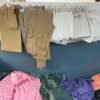Exploring the Carbon Footprint of Textile Manufacturing: Where Do We Stand?
The textile industry plays a crucial role in our daily lives, but it is also one of the largest contributors to environmental degradation. With growing concerns about climate change, businesses and consumers are paying closer attention to the carbon footprint of their choices. This blog explores how traditional textile processes impact the environment, offers insights into calculating carbon footprints, and highlights how Echo Earth is trying to set the new standards with sustainable production. What is Carbon Footprint in Textile Manufacturing? A carbon footprint measures the total amount of greenhouse gases (GHGs) emitted throughout a product’s lifecycle—from raw material extraction to manufacturing, transportation, and disposal. In textiles, these emissions primarily result from energy-intensive processes like: Traditional textile manufacturing emits significant amounts of CO2 and other GHGs, worsening global warming. Understanding and reducing these emissions is critical to making the fashion industry more sustainable and eco-friendlier. Breakdown of Emissions in Textile Processes Calculating the Carbon Footprint Several tools and frameworks help businesses assess their carbon footprint at various stages. The Higg Index and Carbon Trust’s Product Footprint are commonly used to quantify emissions. These frameworks consider factors like energy consumption, water use, transportation emissions, and material choices. How Echo Earth Reduces Carbon Emissions Echo Earth is committed to reducing emissions through the entire lifecycle of our products from scratch to end. Here’s how we do it: 1. Low-Impact Raw Materials: Hemp and Bamboo 2. Energy-Efficient Manufacturing 3. Eco-Friendly Dyeing Practices 4. Local Sourcing and Production 5. Circular Economy Practices Comparing Echo Earth with Conventional Textile Practices Aspect Conventional practises Echo Earth’s approach Fiber source Polyester, Cotton (High Emissions) Hemp, Bamboo (Low Emissions) Energy consumptionDyeing processTransportationWaste Management Fossil Fuel Powered, Chemical Intensive, Global Supply Chains (High Emission), Synthetic Fabrics (Micro Plastic pollution) Energy Efficient Machinery, Biodegradable Dye’s, Local Production, Circular Economy, Zero Waste. By embracing sustainable alternatives, Echo Earth helps reduce carbon emissions throughout the textile value chain. Switching to hemp and bamboo fabrics can lower emissions by up to 50-60% compared to polyester or conventional cotton. How You Can Support a Lower-Carbon Future As a consumer or business, you can make sustainable choices that reduce the textile industry’s environmental impact. Here are a few ways you can contribute: At Echo Earth, we invite everyone to join our mission in building a more sustainable future—one where every garment reflects care for the planet. Together, we can transform the textile industry into a low-carbon, eco-friendly sector that respects nature and people alike. Conclusion The carbon footprint of textiles can no longer be ignored in the fight against climate change. From fibre production to disposal, each stage has an environmental impact, but sustainable practices like those at Echo Earth offer hope for a greener future. Through hemp and bamboo fabrics, energy-efficient manufacturing, and zero-waste initiatives, we are committed to leading the way toward carbon-neutral textile production. As consumers, businesses, and communities unite in choosing sustainable textiles, the shift toward a low-carbon economy becomes not only possible but inevitable. With each conscious decision, we move closer to a cleaner, greener Earth.




